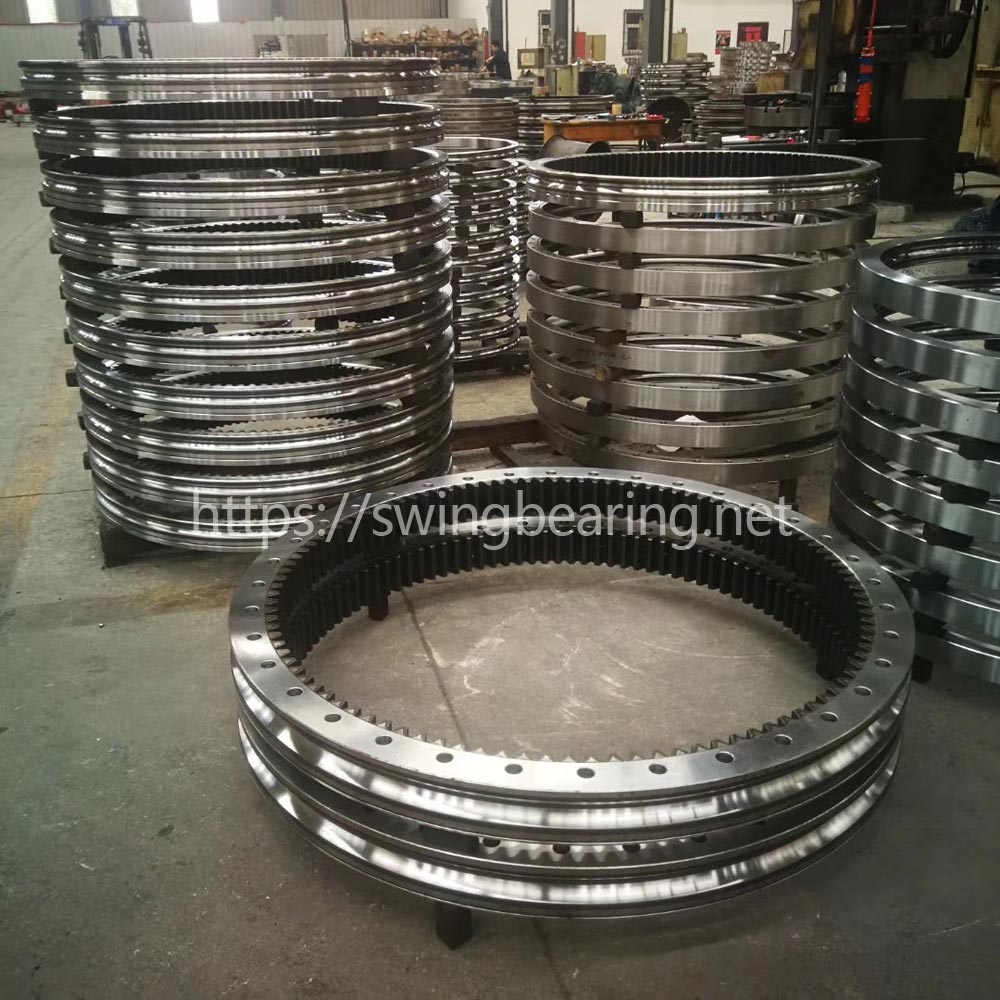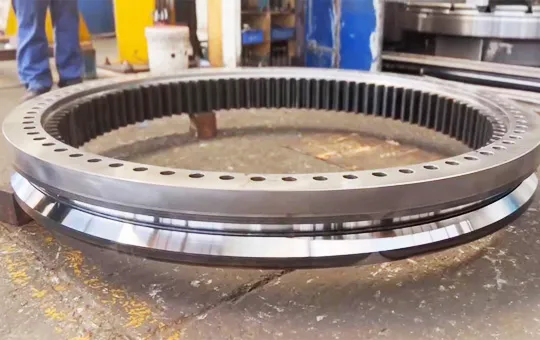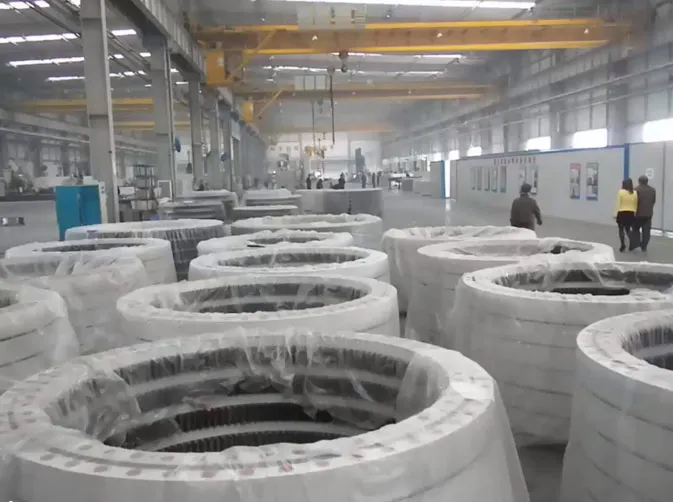
The CAT 385BL excavator is a high-performance machine widely used in construction and mining industries. One of its critical components is the slewing bearing, which enables the upper structure to rotate smoothly. The proper installation and disassembly of the slewing bearing are crucial for maintaining the excavator’s operational efficiency and longevity. This guide provides detailed instructions on the correct procedures for handling the CAT 385BL swing bearing, part number 227-6098, which replaces various other part numbers.
Installing the slewing bearing correctly is essential for the excavator’s smooth operation. The following steps outline the proper installation procedure:
Before beginning the installation process, it is vital to verify the model of the slewing bearing to ensure it matches the required specifications. Check the marking and certificate of the bearing to confirm its compatibility. The installation surface should be free of welding beads, burrs, paint residues, and other contaminants. Use an appropriate cleaning solvent that does not damage the sealing material of the bearing. Ensure the installation surface is dry before proceeding.
The roughness of the mounting surface is a critical factor in the installation of the slewing bearing. It must be carefully controlled within the allowable range and must not exceed the standard value specified for the particular bearing and application. Ensuring that the surface roughness is within these limits is crucial for providing a stable foundation for the slewing bearing. Any irregularities on the mounting surface can lead to uneven load distribution, increased wear, and potential premature failure of the bearing. Therefore, it is imperative to meticulously check and prepare the mounting surface before installation. This preparation involves smoothing out any rough areas, removing any burrs, and ensuring that the surface is flat and clean. By adhering to these standards, you can significantly enhance the performance and longevity of the slewing bearing, ensuring it operates efficiently under the demanding conditions of an excavator.
The preparation of the mounting surface does not end with achieving the correct roughness. It also involves ensuring that the surface is free from contaminants such as dust, dirt, oil, and other residues that could interfere with the bearing’s installation and operation. A clean, smooth surface is essential for the proper seating of the slewing bearing, which in turn affects the stability and reliability of the excavator’s operation. This attention to detail in the preparation phase can prevent future issues and maintenance problems, thereby saving time and costs associated with unexpected downtime and repairs.

The correct positioning of the slewing bearing’s inner and outer raceways is essential for optimal performance. These raceways are designed with a soft belt that must be strategically positioned on both sides of the main load surface. This positioning is typically 90 degrees away from the main load area, a configuration that helps distribute the load evenly across the bearing. By doing so, the bearing’s longevity is enhanced as it reduces localized stress and wear on specific sections of the raceways.
Marking the soft belt with an “S” mark or blocking it for easy identification is a vital step in the positioning process. This mark ensures that during installation, the soft belt is accurately placed in relation to the main load area. The correct positioning of the soft belt is crucial because it helps in balancing the loads and minimizing any potential points of failure. Proper load distribution extends the operational life of the bearing and ensures smoother and more reliable performance of the excavator.
Additionally, during the positioning process, it is important to ensure that the bearing is aligned correctly with the corresponding parts of the excavator. Misalignment can lead to uneven load distribution, which can cause excessive wear, vibration, and potential failure of the bearing. Therefore, precise alignment and positioning are essential steps that should be carried out with great care and accuracy. This process may involve using alignment tools and techniques to ensure that the bearing is perfectly aligned with the mounting structure and other related components.
After the installation of the slewing bearing, a thorough checking process is crucial to ensure that the bearing fits perfectly with the installation surface. This checking process typically involves using a feeler gauge to measure any gaps between the bearing and the mounting surface. The feeler gauge helps in identifying any discrepancies in the fit, which can be crucial for the bearing’s performance and longevity. If any gaps are found, they should be filled with suitable materials to ensure a perfect fit. This step is essential to prevent any movement or instability of the bearing during operation.
The accuracy of this checking process directly impacts the bearing’s performance. A perfect fit ensures that the load is distributed evenly across the bearing, preventing any undue stress or wear on specific areas. It also helps in maintaining the alignment of the bearing with other components of the excavator, which is critical for smooth and efficient operation. Any deviations in the fit can lead to misalignment, increased wear, and potential failure of the bearing.
Once the bearing is installed and checked for a perfect fit, it is important to avoid any actions that could distort or damage the bearing. Specifically, welding the bracket after the bearing has been installed is prohibited. Welding can cause distortion of the bearing rings and raceways due to the heat generated during the process. This distortion can lead to misalignment, uneven load distribution, and increased wear, ultimately compromising the performance and longevity of the bearing. Therefore, all welding and other potentially damaging activities should be completed before the bearing is installed.
By adhering to these meticulous checking and post-installation procedures, you can ensure that the slewing bearing operates at its optimal level, providing reliable and efficient performance for the excavator. This attention to detail in the installation and checking process is essential for maintaining the excavator’s operational efficiency and minimizing maintenance costs and downtime.

Disassembling the slewing bearing correctly is just as important as its installation. The following methods detail the proper disassembly procedures:
When removing the outer ring, fix multiple screws around the outer ring to apply uniform pressure. Turn the screws evenly to remove the ring without causing damage. This method is suitable for bearings with separable components, such as blind plugs and tapered roller bearings. For non-separable bearings, set several incisions on the outer wall, use a nylon spacer and a pressure head, and tap lightly with a hammer to prevent damage.
For through-hole slewing bearings, use a hydraulic press to remove the bearing. Apply force on the inner ring to avoid damaging the outer ring. For large-diameter bearings, use hydraulic disassembly methods by applying oil pressure through the oil nozzle. This makes the bearing easier to pull out. For bearings with a larger inner and outer diameter, the oil pressure method is recommended. Alternatively, the heating expansion method can be used by heating the inner ring to expand it thermally for quick removal.
For threaded hole type slewing bearings, support the inner ring with a stopper and tighten the nut several times before knocking it off with a plastic hammer. The oil pressure method involves pressurizing oil in the bearing’s oil hole to expand the inner ring for disassembly. Be cautious during this process to avoid accidents by using a nut as a baffle.
The knock removal method is a simpler disassembly technique. Apply side impact force with a plastic hammer to displace and separate the bearing components. Before disassembly, add grease to the connection points to facilitate the process. This method is widely used for its simplicity and effectiveness.
Proper installation and disassembly of the CAT 385BL slewing bearing (part number 227-6098) are crucial for maintaining the efficiency and longevity of the excavator. Following the detailed procedures outlined in this guide ensures the bearing is handled correctly, preventing damage and ensuring smooth operation. Proper storage of disassembled parts is also essential to avoid loss and ensure they are in good condition for future use.
By adhering to these guidelines, operators can ensure their CAT 385BL excavator continues to perform reliably, reducing downtime and maintenance costs. Proper handling of the slewing bearing not only enhances the machine’s performance but also extends its operational life, contributing to overall productivity and efficiency.
Q: How frequently should I lubricate the CAT 385BL slewing bearing (part number 227-6098)?
A : Lubrication frequency depends on the operating conditions, but it is generally recommended to lubricate the slewing bearing every 250 hours of operation. In harsh environments, more frequent lubrication may be necessary. Always use the manufacturer-recommended lubricant to ensure optimal performance.
Q: What indicators suggest that the CAT 385BL Swing Bearing 227-6098 requires replacement?
A : Signs that the slewing bearing may need replacement include unusual noises (such as grinding or clicking), excessive play or movement in the bearing, visible cracks or damage to the bearing rings or rolling elements, and leakage of lubricant. Regular inspections can help detect these signs early, allowing for timely replacement.
Q: Is it advisable to use generic parts in place of the specifiedCAT 385BL Swing Bearing 227-6098?
A : While generic parts may be less expensive, they may not meet the exact specifications and quality standards required for optimal performance. Using the specified CAT 385BL slewing bearing (part number 227-6098) ensures compatibility, durability, and reliability, ultimately protecting your investment and maintaining the excavator’s performance.
Q: How do environmental conditions impact the CAT 385BL slewing bearing (part number 227-6098)?
A : Harsh environmental conditions, such as extreme temperatures, dust, dirt, and moisture, can significantly impact the slewing bearing’s performance and lifespan. Contaminants can enter the bearing, causing wear and corrosion. Regular maintenance, including cleaning and proper lubrication, is essential to mitigate these effects and ensure the bearing’s longevity.
Q: What maintenance practices are essential to extend the life of the CAT 385BL slewing bearing (part number 227-6098)?
A : Key maintenance practices include regular lubrication, routine inspections for signs of wear or damage, ensuring proper installation and alignment, and addressing any issues promptly. Using the correct type of lubricant and maintaining a clean working environment also play crucial roles in extending the bearing’s life.
In conclusion, understanding the proper installation and disassembly methods for the CAT 385BL slewing bearing, as well as adhering to regular maintenance practices, ensures the longevity and optimal performance of the excavator. This guide serves as a comprehensive resource for operators and maintenance personnel, providing the knowledge necessary to handle the slewing bearing with care and precision.